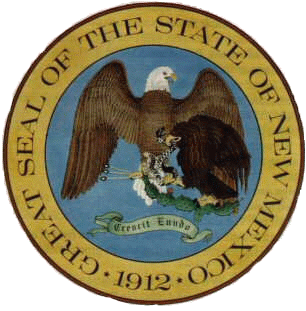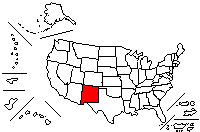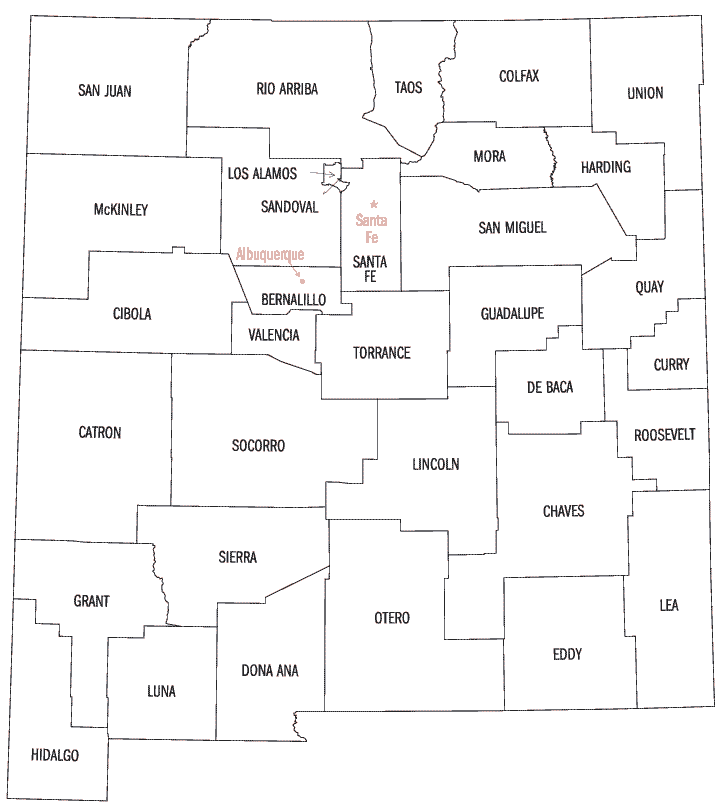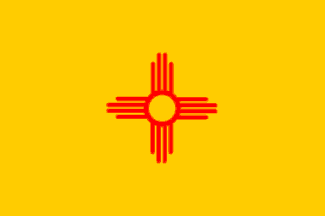
 |
|

















O, Fair New Mexico |
Oh, Bello Nuevo México |


Flag:
New Mexico Statutes Annotated
12-3-2. [Adoption of flag for state of New Mexico.] That a flag be and the same is hereby adopted to be used on all occasions when the state is officially and publicly represented, with the privilege of use by all citizens upon such occasions as they may deem fitting and appropriate. Said flag shall be the Native American people called the Zia sun symbol of red in the center of a field of yellow. The colors shall be the red and yellow of old Spain. The proportion of the flag shall be a width of two-thirds its length. The sun symbol shall be one-third of the length of the flag. Said symbol shall have four groups of rays set at right angles; each group shall consist of four rays, the two inner rays of the group shall be one-fifth longer than the outer rays of the group.
The Zia believed that the giver of all good gave them gifts in groups of four. These gifts are:
The four directions - north, east, south and west.
The four seasons - spring, summer, fall and winter.
The day - sunrise, noon, evening and night.
Life itself - childhood, youth, middle years and old age.
All of these are bound by a circle of life and love, without a beginning or end.
The diameter of the circle in the center of the symbol shall be one-third of the width of the symbol. Said flag shall conform in color and design described herein.
The First Flag
of New Mexico statehood was designed by New Mexico
historian Ralph Emerson Twitchell, as authorized in 1915. I
t consisted of a blue field with a miniature United States flag in the upper left corner,
the state’s great seal in the lower right corner and “New Mexico” embroidered diagonally
across the field from the lower left to the upper right corner.
In 1920, the New Mexico Chapter of the Daughters of the American Revolution (D.A.R.)
advocated the adoption of a flag representative of New Mexico’s unique character.
Three years later, the D.A.R. conducted a design competition which was won by the distinguished
Santa Fe physician and archeologist, Dr. Harry Mera. The doctor’s wife, Reba, made the
winning flag design with a symbolic red Zia on a field of yellow. In March of 1925,
Governor Arthur T. Hannett signed the legislation which proclaimed the Mera design as the
official state flag.
The State Flag of New Mexico has a modern interpretation of an ancient symbol of a sun
design as seen on a late 19th century water jar from Zia Pueblo.
This pueblo is thought to have been one of the Seven Golden Cities of Cíbola,
which explorer Vásquez de Coronado sought.
The red and yellow are the colors of Isabel of Castilla which the Spanish
Conquistadors brought to the New World.
The flags of Spain, the Republic of Mexico, the Confederate States of America,
and the United States of America have all flown over the “Land of Enchantment”
during the long history of the state.
Officual Salute to the Flag:
This salute are in two language: English and Spanish.
English - “I salute the flag of the State of New Mexico and the Zía symbol of perfect friendship among united cultures.”
Spanish - “Saludo la bandera del estado de Nuevo Méjico, el simbolo Zía de amistad perfecta, entre culturas unidas.”
The words to the salute were composed by Mrs. T.K. Martin, Mrs. W.B. Oldham, Mrs. Thomas E. Mears, Jr., and Mrs. James D. Turner of the Portales Chapter of the United Daughters of the Confederacy. Mr. Thomas E. Mears, Jr. wrote the proposal for presentation to the 26th Legislature which adopted the salute on March 13, 1963. The Spanish version was translated by Maria E. Naranjo of Larragoite School in Santa Fe, and adopted by the 31st Legislature in 1973.
Bandera:
Los estatutos de Nuevo México adoptado en
12-3-2. [ adopción de la bandera para el estado de Nuevo México. ]
Que una bandera será adoptada para ser usada en todas las ocaciones cuando el estado esté oficial y publicamente representado, con el privilegio de ser utilizado por todos los ciudadanos en todas las ocaciones que crean que sea apropiado. Dicha bandera será el antiguo simbolo del son de Zia en rojo en el centro en un campo amarillo. Los colores serás los mismos rojos y amarillos de la Bandera de la antigua España.
La
proporción de la bandera será una anchura de dos tercios de su
longitud. El símbolo del sol será una mitad de la longitud de la
bandera. Dicho simbolo tendrá cuatro grupos de rayos fijados perpendicualarmente que consistirá de cuatro rayos cada uno, los dos rayos internos serán un quinto más largo que los dos rayos externos. Los Zia creían que el dador de todo lo bueno le daba regalos en grupos de cuatro. Estos regalos son: La cuatros direcciones - notre, sur, este y oeste. Las cuatros estaciones - primavera, verano, otoño e invierno. El día - amanecer, atardecer, anocheser y la noche. La vida - niñez, juventud, edad media y vejez. Todo ellos al rededor de un circulo d la vida y amor, sin un principio y fin.
El diámetro del círculo en el centro será la mitad de la anchura del símbolo.
La Primera Bandera
del estado de Nuevo México fue por un historiador de ese estado llamado Ralph Emerson Twitchell, como fue autorizado en el 1915.
Consistía en un campo azul con la bandera de los Estados Unidos en miniatura en la esquina izquierda arriba, el sello del estado en la esquina inferior derecha y "Nuevo México" cruzando el campo azul de derecha a izquierda de abajo hacia arriba.
En el 1920 el nuevo capitulo de Las Hijas de la Revolución de Nuevo México solicitó la adopción de una nueva bandera que fuera representativa del carácter único de Nuevo México. Tres años después se organizó una competencia de diseño para una nueva bandera el cual fue ganado por un distinguido físico y arqueólogo Dr. Harry Mera. Su esposa, Mera, hizo la bandera con una simbolica Zia roja en un campo amarillo. En el 1925 el gobernador Arthur T. Hannett firmó la legislación el cual proclamaba ese diseño como la bandera oficial del Estado.
El estado de Nuevo México tiene una nueva interpretación de un simbolo del sol como fue visto a finales del siglo 19 en una jara de agua de la tribu
Zia Pueblo. Se piensa que este pueblo fue una de las sietes ciudades doradas de Cíbola, el cual el explorador Vázquez de Coronado vió.
El rojo y el amarillo son los colores de Isabel de Castilla el cual los conquistadores españoles trajeron al nuevo mundo.
Las banderas de España, México, Los Estados Confederados de América y Los Estados Unidos de América han sido enarboladas en este estado durante su larga historia.
Saludo Oficial de la Bandera
Este saludo está en dos idiomas: Españo e Inglés.
English - “I salute the flag of the State of New Mexico and the Zía symbol of perfect friendship among united cultures.”
Spanish - “Saludo la bandera del estado de Nuevo Méjico, el simbolo Zía de amistad perfecta, entre culturas unidas.”
Las palabras de este saludo fueron escritas por Mrs. T.K. Martin, Mrs. W.B. Oldham, Mrs. Thomas E. Mears, Jr. y Mrs. James D. Turner del capitulo de la hijas de la Confederación unida de Portales. Mr. Thomas E. Mears, jr. escribió la propuesta para ser presentada en la legislatura y fue adoptado, el saludo el 13 de marzo de 1963. La versión en españo fue traducido por María E. Naranjo of la escuela de Larragoite en Santa Fé y adoptado por la legislatura en el 1973.

New Mexico
Capital City: Santa Fe
Admission to Statehood: January 6, 1912
Border States: Arizona Colorado Oklahoma Texas Utah.
Motto: Crescit eundo (“It Grows as It Goes”)
This motto, which has its origins in classical Latin literature, has been in use since 1851, when the territorial seal was first designed. It is a statement of belief in growth and progress. True to New Mexico’s belief in growth and progress, the legislature adopted a slogan in 1975; the offical state slogan for business, commerce, and industry in New Mexico is “Everybody is Somebody in New Mexico.”
National: New Mexicans
Nickname: Land of Enchantment
Origin of state's name:
Named by Spanish
Admitido como estado: 6 de enero de 1912
Estados limítrofes: Arizona Colorado Oklahoma Texas Utah.
Lema: Crescit eundo (crese mientras siga)
Este lema tiene su origenes en la literatura latina clásica y ha sido usado desde el 1851, cuando el sello territorial fue diseñado. Es un dicho que cree en el crecimiento y progreso.
Esa creencia de Nuevo México en el crecimeinto y progreso, la legislatura lo adoptó un lema en el 1975 para el comercio, negocio y la industria de Nuevo México que es: "Todo las personas son alguien en Nuevo México".
Gentilicio: Novo Mexicanos
Cognómento: Tierra del Encanto
Origen del nombre: dado por los Expañoles


Great Seal:
New Mexico's first seal was designed shortly after the organization of the Territorial Government, in 1851. The original seal has long since disappered, possibly as part of the artifacts placed into the cornerstone of the Soldiers Monument in the Santa Fe Plaza. Imprints of the original seal show it consisted of the American Eagle, clutching an olive branch in one talon, and three arrows in the other. Along the outside rim was the inscription "Great Seal of the Territory NM."
In the early 1860's an unknown official adopted a new seal, using a design similar to today's Great Seal. It featured the American Bald Eagle, its outstretched wings shielding a smaller Mexican Eagle, symbolizing the change of sovereignty from Mexico to the United States in 1846. The smaller Mexican Brown, or Harpy, Eagle grasped a snake in its beak and cactus in its talons, portraying an ancient Aztec myth. The outside rim of the seal contained the words "Territory of New Mexico," with the date of 1850 along the bottom in Roman numerals (MDCCCL).
It is not clear when the Latin phrase "Crescit Eundo" was added to the seal, but in 1882, Territorial Secretary W.G. Ritch embellished the earlier design with the phrase, which translates as "it grows as it goes". This version of the seal was adopted as New Mexico's "official seal and coat of arms" by the Territorial Legislature in 1887.
When New Mexico became a state in 1912, the Legislature named a Commission for the purpose of designing a State Seal. In the meantime, the Legislature authorized interim use of the Territorial Seal with the words "Great Seal of the State of New Mexico" substituted. In June 1913, the Commission, which consisted of Governor William C. McDonald, Attorney General Frank W. Clancy, Chief Justice Clarence J. Roberts, and Secretary of State Antonio Lucero, filed its report adopting the general design of the Territorial Seal, substituting only the date 1912 for the Roman numerals. That seal is still in use today as the official seal of New Mexico.
Gran Sello
El primer sello fue diseñado poco después de la organización del gobierno territorial de Nuevo México en el 1851. El antiguo sello duró hasta que desapareció, posiblemente esté como parte de los emblemas colocados dentro de una esquina de piedra en el monumento a los soldados en la Plaza de Santa Fé. El antiguo sello consistía de una ágila americana sujetanto unarama de oliva en una grarra y tres flechas en la otra. Al rededor estara la inscripción "Gran Sello del Territorio de NM". A principios de 1860 un desconocido oficial adoptó un nuevo sello con un diseño parecido al actual. Este presenta un águila calva americana con sus alas extendidas escudando una pequeña águila mexicana, simbolizando el cambio de soberanía de México hacia los Estados Unidos en el 1846. La pequeña águila mexicana en marrón agarrando una serpiente con su pico y su garra en representación a un antiguo mito azteca. Al rededor del sello aparecen las palabras "Territorio de Nuevo México" con la fecha de 1850 en números romasno (MDCCCL). No setá claro cuando el lema se sello fue añadido, pero en el 1882, el secretario territorial W.G. Ritch embelleció la antigua versión con la frase "Crese mientras sigua". Esta versión fue adoptado en Nuevo México como sello oficial y escudo de armas por la legislatura territorial en el 1887. Cuando Nuevo México se convirtió en estado en el 1912, la legislatura nombró una comisión con el propósito de diseñar un sello estatal. En el 1913 se adoptó el antiguo sello territorial el cual solo se le cambió la fecha en números romanos por la fecha de 1912. Este sello se sigue utilizando hasta el día de hoy.
